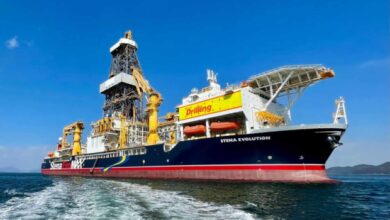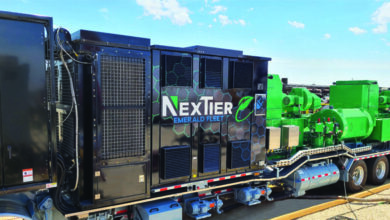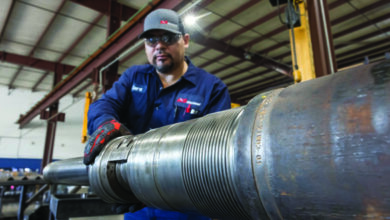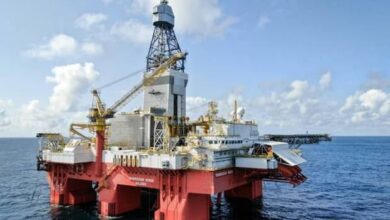Deep Gulf of Mexico completions push equipment to their limits – and maybe beyond
By Katie Mazerov, contributing editor
As the Region moves into production phase, operators are taking careful steps to find and fill equipment gaps.

Halliburton’s Champ XHP retrievable service packer is rated to 15,000 psi and 400°F. It’s designed for highly deviated and deeper wells, which pose problems with the transmission of torque required to operate retrievable services tools. Non-rotational tools are said to be in development to address the torque issue.
Not knowing what you don’t know is a risky place to be when you’re staring down a 30,000-ft well. No one knows that better than Doug Bolingbroke, Gulf of Mexico completion team leader for Hess Corp, who has spent two years engaged in the front end engineering design (FEED) for wells in the Gulf’s Green Canyon Pony development. “These would be the deepest completions yet in the Gulf of Mexico,” he noted.
The wells, which will require multi-zone sand control and multi-zone water injectors at depths up to 32,000 ft, are pushing the envelope on existing technology. And the uncertainty of how far those tools can be pushed and how well new equipment will perform is a critical consideration in pursuing a multibillion-dollar endeavor.
“We can’t take anything for granted, because we haven’t done this before,” Mr Bolingbroke said. He is scheduled to make a presentation, “Equipment Gaps at 30,000 Feet,” at the 2009 IADC Completions Conference, 17 November in Houston.
“So we’re going to the next nearest thing we can find,” he continued. “There are some developments in the GOM that are around 26,000 ft and you think, ‘Is there really that much different from 29,000, 30,000 feet? That’s only 20%.’ But the point is, you realize you’re already at the limit, and you’re trying to stretch it a little bit further. So we have to go back to the basics.”
Complex completions are nothing new to an industry that in the last 10 to 15 years has come to grips with the reality that easy-to-tap resources are dwindling on land and at sea. Well depth, compartmentalized and depleted reservoirs, long intervals, high-pressure and high-temperature and H2S (sour gas) wells are among the difficult conditions that are now commonplace.
“The shale plays that are being completed today require multiple pinpoint stimulations to maximize well productivity,” said Mike Vinzant, group manager for Halliburton completion tools. “The deeper shale plays require completions tools with 10,000-psi pressure rating and temperature ratings above 380°F. This is challenging the providers of composite products.”
Deepwater environments also require complex completion designs. “The water depth can necessitate the need for chemical and hydrate injection, permanent monitoring, deep-set subsurface safety valves, combined with the added complexity associated with a single or dual riser design for dry tree completions,” Mr Vinzant continued. “The longer reservoir intervals encountered in the GOM Lower Tertiary have raised the requirement for frac vessels to have increased proppant volume and fluid volume capability that enable the vessel to remain on station for multiple frac pack treatments.”
 Wells in the Gulf of Mexico’s Green Canyon Pony development require multi-zone sand control and multi-zone water injectors at depths up to 32,000 ft. Operators are uncertain how far current equipment can be pushed and how well new equipment will perform. It’s a critical consideration due to the high cost of these deepwater operations.
Wells in the Gulf of Mexico’s Green Canyon Pony development require multi-zone sand control and multi-zone water injectors at depths up to 32,000 ft. Operators are uncertain how far current equipment can be pushed and how well new equipment will perform. It’s a critical consideration due to the high cost of these deepwater operations.
But it is the ultra-deep wells in the resource-rich Gulf of Mexico where much of the focus is today. Operators are just beginning to move from the exploration to the production phase in the region, and it’s a slow and deliberate process.
“There are two big issues in completing these ultra-deep wells,” Mr Bolingbroke explained. The first involves the sheer scale of the undertaking. “The weight and tensile load required in these completions are enormous,” he said. “We’re talking about a casing string that weighs two million pounds and a drill pipe that is six miles long.
“The second issue is the trip time,” he continued. “It will take several days to screw together the drill pipe to get from the rotary table to the bottom of the well. And if you get to the bottom and realize the tool you just ran doesn’t work right, you’ve got to pull out of the hole and fix it. That’s millions of dollars.”
With the financial stakes so high, Mr Bolingbroke and his team are looking at ways to measure the impact of unknowns or risks. “We can factor in a 10% contingency, but when you’re talking about a $4 billion operation, adding on 10% is a fairly high number.”
What is becoming apparent is that the philosophy and general design of the completions is not a significant issue.
“For example, on a tubing string or drillstring design, yes, you have to make it stronger and you are going to need a design to handle the tensile load, and it’s going to have to be a very robust connection,” Mr Bolingbroke said. “But you have to go through the process. Using the same design parameters, you just have to take into consideration the depth and the pressure.”
Depth, both water depth and depth below the mudline, pose significant challenges for operators in terms of high-pressure sand control and improving productivity of competent formations that require stimulation, said Kevin Lacy, vice president drilling completions, Gulf of Mexico for BP.
“Arguably, this arena is one of the tougher environments for completions,” he said. “The reason people are pursuing these areas is because there is an abundance of resources, and there does appear to be a fairly big prize there. The question is, can we get those resources out at a high enough rate and at a low enough cost?
That dilemma is not new to the business, it’s just that this one has some pretty significant technical challenges.”
The industry is still very early in the game, with few producers in this new, extreme subsurface environment. To date, it has been mostly exploration discoveries and appraisal wells. “We are just starting to figure out what the challenges for these wells look like, the limits of the current equipment, and the way we actually do things now,” Mr Lacy explained. BP currently has deepwater exploration endeavors under way in the Gulf of Mexico, Angola, Egypt, and soon in Libya.
Technology in this case is an umbrella term that really means finding reliable equipment and materials, developing a process for installing that equipment, then developing the tools to maintain the wells over a long enough life to be profitable.
 This WellWatcher Flux system was installed in Asia in May 2008 as part of a multiple-well project in a subsea field to allow flow-profile monitoring across the entire reservoir.
This WellWatcher Flux system was installed in Asia in May 2008 as part of a multiple-well project in a subsea field to allow flow-profile monitoring across the entire reservoir.
“Some fields are more challenging because they are physically at depths that really have limits in using current operating equipment and procedures,” Mr Lacy said. “Some are challenging because of what we’re trying to pull off in terms of the amount of reservoir we’re trying to access in one well – a long, multiple sand section that we need to complete under very harsh conditions. That’s a problem in and of itself as we’re trying to do it at the limits of the equipment and also achieve a big technical feat in either improving productivity or avoiding sanding with high rates.”
And conditions that are already difficult in onshore and shallow-water environments are even more daunting at greater water depths.
“There usually is a requirement for sand control, so in many formations we have to find a way to keep the sand in place in these long intervals and at high producing rates – that is a big challenge,” Mr Lacy noted.
“In other cases, the rock is fairly competent but has low productivity, so we need to stimulate the reservoir itself with a frac, which is very complicated to do at these depths offshore. Onshore fracing is done routinely in tight but relatively shallow formations, so the frac pressures are moderate,” he continued. “But as you go deeper, the pressures go higher, and we’re also in the deepwater offshore environment.”
In this early stage of exploration into the ultra-deep well environment, the industry is learning how far existing equipment can be pushed and determining which new technologies are going to provide the biggest rewards for the risks.
“There is always the opportunity to make use of existing, but perhaps underused, technology,” said John Lovell, system manager, distributed temperature at Schlumberger. “You have to be careful not to develop new technology just because it’s sexy, when maybe a gentle refinement of an existing product might suit the market better.”
That said, Schlumberger recently introduced some new tools in its WellWatcher real-time reservoir and production monitoring system series of intelligent tools. These new tools offer a logging-while-producing functionality to gain more accurate and continuous real-time data from permanent sensors in deep subsea wells.
“One of the issues causing measurement gaps in the subsea environment involves gaining subsequent access to the well once we’ve completed it,” Mr Lovell explained. “It is very difficult to get back to these wells later for workovers, intervention or to retake measurements.” Another challenge involves the ability to measure and control the flow of various zones within a well.
Schlumberger’s WellWatcher Flux digital sensor array system, recently deployed in Southeast Asia, has been designed to provide a series of measurements that will ultimately offer the same functionality as existing production logs.
“A lot of these subsea wells are deployed in multiple stages, and one of the challenges has been wiring all of that up,” Mr Lovell explained. “How do you get power and data down to the sandface of those kinds of wells? WellWatcher Flux addresses that issue by providing a wireless short-hop telemetry and power transmission system so we can activate sensors on the sandface.
“With this system, when we have a number of wells instrumented, that data is flowing continuously so we can match the data coming from one well against the data coming from another well and put it into an overall complete reservoir perspective,” he continued.
“By coming up with a better understanding of the reservoir and to allow drainage by drilling one or two fewer wells, the cost benefits to the operators are enormous.
“We have a number of wells where we have data coming off a number of sensors on the sandface of those wells,” Mr Lovell said. “But it really doesn’t help anybody if all we’re doing is adding more data points. This system includes communication and interpretive packages that allow operators to utilize the data within their reservoir analysis workflows and thereby maximize the productivity of the well.”
In the Gulf of Mexico, where wells are significantly deeper, monitoring of the upper completion can also significantly reduce risk. For this application, Schlumberger has deployed its WellWatcher Neon hybrid opto-electric permanent monitoring system that integrates a fiber-optic line with an electric line in the same cable to provide tubing integrity monitoring and simultaneous acquisition of pressure gauge data and distributed temperature data at very long distances and high pressures.
As activity continues to build in the ultra-deep well market, service companies are focusing on developing an array of tools and equipment to deal with two key drivers that require complex completions: extreme high pressure and temperature.
“The major equipment gaps in this theater fall into the ultra-high pressure and high temperature (HPHT) category,” said Tommy Grigsby, Halliburton’s product manager for sand control tools. “These wells require tubing strings, production packers or seals and accessory items that can handle the burst, collapse and tensile forces, compounded with elevated temperatures encountered during a well’s producing life. In addition, customers are increasingly requesting expanded tool capability with an eye toward reducing complexity and enhanced debris tolerance.”
Halliburton’s Champ XHP retrievable service packer, rated to 15,000 psi and 400°F, is designed specifically for highly deviated and deeper wells. These wells pose problems with the transmission of torque required to operative retrievable services tools,” Mr Grigsby said. “Non-rotational tools are being developed to address the torque issue.”
But engineers and equipment designers are being pressed to develop completions systems that offer broader solutions rather than just specific tools. “With these types of applications, it’s important to consider more system integration, that is bringing all the different products together and looking at the completion as an overall package as opposed to individual tools,” Mr Grigsby said.
And because of the higher spread rates associated with deep and ultra-deep wells, there is also increased emphasis to develop completion hardware offline. “This has added a significant burden to existing test facilities to adequately test the designs prior to running them in the hole and to ensure that the ‘whole’ system is compatible,” he added.
Tools can be developed relatively quickly, especially in situations that involve an incremental design. Still, the time frame for new equipment to reach the marketplace and gain acceptance by the industry can take up to 10 years.
“Developing a new system is only part of the equation,” Mr Grigsby noted. “While new ideas are often readily available, it requires visionary operators to see the value of that technology, accept the design and qualification rigor already expended and employ the new tool or technique in their completions.”




